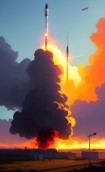|
MikeC posted:It is actually the opposite. Almost all lessons learned since WW2 is that modern wars between high tech adversaries are decisive within a few weeks. You typically have to expect to fight with what you have given the lethality of modern systems. I'm not sure this statement can be supported as strongly as you put it here. Though it's true that many Cold War conflicts tended to be brief, this is arguably as much a result of diplomatic pressure from either or both superpowers to contain the conflict before it got out of hand as it was a necessary result of technology, as well as a reflection in many cases of the limited size and/or goals of the combatants involved. As well, in the time period you list the big standouts like the Korean War or the Iran-Iraq War (or indeed the Ukrainian War) may be more limited in number but they do demonstrate that the possibility of a long war between technologically advanced modern combatants is still possible given the right conditions - the question then is what those conditions are exactly, and are they likely enough to be worth preparing for? In particular I note that the examples of the wars that lasted longer include countries that tend to be, well, larger than the shorter examples, and tended to include more decisive aims on both sides - it may be that a potential WW3 scenario between superpowers may involve a brief period of shattering violence as existing stocks are used up, followed by a lower-intensity phase as the powers husband the resources they have available and spool up production of new equipment, if both sides consider the conflict important enough to keep fighting on for. In that respect, Ukraine may very well be a model for what a modern land war would look like between larger adversaries of similar technology and similar dedication to accomplishing their aims. MikeC posted:Arab Israeli wars are foundational for understanding how western militaries view conflicts. In all 3 wars since Israel's foundation, wars were decisive well before any kind of expectation for industry to meaningfully contribute to war stocks. I don't think that it would be uncontroversial to say that while the Israeli Wars and the Gulf War may have shaped military thinking, the Ukrainian War is also going to be a treasure trove of lessons learned for years to come, and one that is all the more important for being more recent and between larger opponents. As regards your second paragraph, doesn't this arguably demonstrate the potential importance of industrial lines? If a war can be turned around by a steady supply of new ammunition, wouldn't it indicate that it may be of value to be able to ensure a large and steady supply of such in a new war, and that relying purely on pre-existing stocks may leave you vulnerable to defeat if you run out before the enemy does? Indeed, isn't the fact that Ukraine was still standing and able to call for new stocks of ammunition itself proof that they weren't decisively defeated in the opening weeks, the intensity of modern warfare notwithstanding?
|
|
|
|

|
| # ? May 23, 2024 17:14 |
|
Tomn posted:Indeed, isn't the fact that Ukraine was still standing and able to call for new stocks of ammunition itself proof that they weren't decisively defeated in the opening weeks, the intensity of modern warfare notwithstanding? I agree that this is actually one of the key lessons from this conflict is that you can survive the initial ruinous haymaker western planners are envisioning by having highly mobile and distributed operating bases.
|
|
|
|
Hannibal Rex posted:https://twitter.com/ElbridgeColby/status/1599778801965211649?t=nt6NUrCWVTpwNeKthsB4sw&s=19 This is a quote from the article: Lawmakers are also concerned about how much more appetite the American public has given the ever-ballooning price tag. “I think we all have been so impressed by the Ukrainians and you’ve got to back them as much as possible,” said Rep. Elissa Slotkin (D-Mich.), a former DoD and CIA official. “But I knocked on 80,000 doors and Ukraine came up in my election in Central Michigan. People are like, ‘I really support them and I want them to succeed, but when do we stop giving billions of dollars and is there an endgame?’ This really irks me. I'm an American and I have a really cynical view of how our government spends money. People seem to think that if we stop funding foreign aid and military adventures that the money will instead be used for helping Americans here at home. That has never been the case, and it never will be. We probably could have funded healthcare for all with the billions we were shoveling into the Iraq war quagmire. But I also know that if that war never happened those billions still wouldn't have been spent on improving the lives of Americans. So I say, if we are going to spend money abroad it might as well be for a good cause like helping the Ukrainians because it's not like we are going to see that money spent here anyway.
|
|
|
|
Saint Celestine posted:I don't think there is a US equivalent of the Gepard? IIRC, the closest thing is the avenger? which is missiles only? M247 but it got cancelled before deliveries. Later ADATS, also cancelled.
|
|
|
|
The big war with Russia that the US has been preparing for since the end of the 40's is here, and it's the Ukrainians fighting it for them for pennies on the dollar. It's pretty disheartening that the average American doesn't understand this but I have long since given up on them.
|
|
|
|
spankmeister posted:The big war with Russia that the US has been preparing for since the end of the 40's is here, and it's the Ukrainians fighting it for them for pennies on the dollar. It's pretty disheartening that the average American doesn't understand this but I have long since given up on them. Like half of Americans don't care about preserving or fighting for our democracy here at home why would they care about fighting for someone else's democracy on the other side of the world.
|
|
|
|
spankmeister posted:The big war with Russia that the US has been preparing for since the end of the 40's is here, and it's the Ukrainians fighting it for them for pennies on the dollar. It's pretty disheartening that the average American doesn't understand this but I have long since given up on them. it happened already in the fifties in korea
|
|
|
|
MikeC posted:Thanks to the Russians, they had gear that was on par with the Israelis. nah israel had a technological edge
|
|
|
|
It seems like the framing of Ukraine spending is bad, because the "correct" framing (that this is unbelievably efficient military spending that is directly degrading the war fighting ability of America's nominal biggest adversary) implies a level of direct confrontation with Russia the gov't can't/won't acknowledge, so it gets framed as foreign aid.
|
|
|
|
cinci zoo sniper posted:thereís no telling, as yet, to what specifically happened at the Engels base. Russia is saying that Ukraine attacked the airbases directly, which seems to jive with the videos that came out ( https://www.bbc.com/news/world-europe-63857451 ). Russia has admitted damage to two airframes, which, based on previous Russian reporting, probably indicates that a handful of aircraft were destroyed. Maybe we'll get satellite images. Otherwise who knows, but in general the trend seems to be that you can multiply anything Russia admits about damage to it by about 10.
|
|
|
|
mllaneza posted:A fuel truck at the Ryazan airbase exploded, 3 dead. They're going to have to keep cracking down on smoking on military bases. https://twitter.com/RALee85/status/1599828840078942208
|
|
|
|
spankmeister posted:Anti air cannons were considered a bit of a technological dead end, missiles being far more effective. Note that this is not quite right, the DoD first added the requirement of "every loving vehicle that can move under it's own power gets light gun AA" to the NGCV program in 2018, based not on any real experience in any war, but their own experience testing and training with drones stateside. They'd be hailed as great visionaries right about now, except that procurement is hosed enough that this poo poo got proven in actual wars before anything has been bought or built.
|
|
|
Saladman posted:Russia is saying that Ukraine attacked the airbases directly, which seems to jive with the videos that came out ( https://www.bbc.com/news/world-europe-63857451 ). Russia has admitted damage to two airframes, which, based on previous Russian reporting, probably indicates that a handful of aircraft were destroyed. Maybe we'll get satellite images. Otherwise who knows, but in general the trend seems to be that you can multiply anything Russia admits about damage to it by about 10. Z-grams seems to be calibrating around Tu-141 theory, the same model that fell in Croatia in March. Not sure if this is Kots trying to scrounge up at least something or not.
|
|
|
|
|
spankmeister posted:The big war with Russia that the US has been preparing for since the end of the 40's is here, and it's the Ukrainians fighting it for them for pennies on the dollar. It's pretty disheartening that the average American doesn't understand this but I have long since given up on them. In fairness, I don't think most US citizens would have regarded a war with Russia as a desired outcome to begin with - something to be prepared for, sure, but not welcomed except by General Ripper types. The fact the war is being fought in a manner that is efficient for US strategic purposes doesn't really change that.
|
|
|
|
cinci zoo sniper posted:Z-grams seems to be calibrating around Tu-141 theory, the same model that fell in Croatia in March. Not sure if this is Kots trying to scrounge up at least something or not. https://mobile.twitter.com/RALee85/status/1599833639201619969 ("another" compared to one that shows mostly a burned out truck blocking the view of the plane and something that looks like it may be blood)
|
|
|
|
OddObserver posted:https://mobile.twitter.com/RALee85/status/1599833639201619969 Or hydraulic fluid.
|
|
|
|
Tuna-Fish posted:Note that this is not quite right, the DoD first added the requirement of "every loving vehicle that can move under it's own power gets light gun AA" to the NGCV program in 2018, based not on any real experience in any war, but their own experience testing and training with drones stateside. They'd be hailed as great visionaries right about now, except that procurement is hosed enough that this poo poo got proven in actual wars before anything has been bought or built. Yeah, Nagorno Karabakh was, from the standpoint of drone development, probably most comparable to where the most advanced drone tech was back in 2005 or at latest 2010. Even ISIS's light drone stuff was mid 2010s. The writing has been on the wall about drones for a long time. Charliegrs posted:This is a quote from the article: Yeah there's a big disconnect between how much of a sacred cow the deterrence-oriented defense spending truly is and how people on the street, so to speak, view defense spending. The need for deterrence is just a foundational part of the American state in its current form and any idea that that is going to be compromised upon in any significant way just does not have any connection to any near or mid term reality. Herstory Begins Now fucked around with this message at 00:49 on Dec 6, 2022 |
|
|
|
https://mobile.twitter.com/steveashleyplus/status/1599724840315146241 Wtf was Ukraine doing?? A fifth of a million tons
|
|
|
|
Theyíre still using TU-22s? I thought those were, like, B-58 Hustler equivalents.
|
|
|
|
Vox Nihili posted:Everyone in the article says it's normal to take 3 years to increase production of shells. Hilarious how accustomed we've become to industry being ossified to the point of being 90% dead in the US. Even the MIC is little more than a shambling zombie from which rent can be sucked at the maximum possible margin. The US is the world's 2nd largest manufacturer by a large margin. We produce more than countries 3-5 combined (Japan, Germany and India).
|
|
|
|
cinci zoo sniper posted:Z-grams seems to be calibrating around Tu-141 theory, the same model that fell in Croatia in March. Not sure if this is Kots trying to scrounge up at least something or not. https://twitter.com/JosephHDempsey/status/1599886567455084544?t=Dxd1TAG6jq3vAnd1PQy0YA&s=19 Yeah, here's a picture as a reminder.
|
|
|
|
What would be the advantage of a weaponized Tu-141 vs a traditional cruise missile? Is the Tu-141 steerable on the way to its target?
|
|
|
|
I assumed it was a question of availability
|
|
|
|
WarpedLichen posted:What would be the advantage of a weaponized Tu-141 vs a traditional cruise missile? Is the Tu-141 steerable on the way to its target? Ukraine has Tu-141s. As for cruise missiles, they were pressured in giving them away for security phone not swears.
|
|
|
|
Charlz Guybon posted:The US is the world's 2nd largest manufacturer by a large margin. We produce more than countries 3-5 combined (Japan, Germany and India). The US produces a lot of food, chemical products, paper products, single-use consumer products, and a decent chunk of high-end technology products and vehicles, as measured in dollars. In terms of manufacturing output in tons of durable products, the US outsourced as much of that as possible decades ago. We are basically on par with Russia in this regard, and with zero excess capacity. Steel, aluminum, etc. are largely gone. The grandchildren of the last people who worked in those old, defunct plants are being born in dead rust belt cities. We only recycle steel from scrap here now, for example, we don't make new steel. We are entirely reliant on brittle international supply chains for most products. The second there are issues in China or with shipping, as we've seen these past couple years, our entire supply chain instantly seizes up and shits itself. This is the price our industrialists happily paid to kill off labor. Now it apparently takes three years to even source materials and tool up lines to double shell production. China could probably do it in three weeks.
|
|
|
|
WarpedLichen posted:I agree that this isn't really a war that anybody really expected to fight (though Russia really should've planned for this as the aggressor), but how exactly are you defining "peer conflict" in this case? Russia did plan, they just didn't tell the troops or commanders of the primary objective of the said plan until 9 hours beforehand. Back in v1 of this thread, I had speculated that the invasion was an off-the-cuff decision when negotiations broke down since no one would be that unprepared. Now we know for sure that the invasion was preplanned months in advance but the orders literally didn't go down to commanders until the night before. When people say peer conflict, it means opposing forces with modern technological capabilities matching each other in the anticipated zones of combat and the training to use it. IE, USA vs China within the first island chain or up to very recently, Russia, within the confines of Eastern Europe or say India vs Pakistan. In this case, the Ukrainians are not peer opponents. Though modernization updated its tank fleet to servicable standards, the Ukrainians were flying fighter jets a full "generation" behind Russia's best jets. It has no long-range strike capabilities to retaliate against Russian missile strikes on its infrastructure and is now wholly reliant on the west for arms and ammunition. Even though they have weathered the storm, it is clear much of their war effort leans on western arms and ammunition as well as the intelligence gathering apparatus that is in place to support Kyiv. Tomn posted:I'm not sure this statement can be supported as strongly as you put it here. Though it's true that many Cold War conflicts tended to be brief, this is arguably as much a result of diplomatic pressure from either or both superpowers to contain the conflict before it got out of hand as it was a necessary result of technology, as well as a reflection in many cases of the limited size and/or goals of the combatants involved. As well, in the time period you list the big standouts like the Korean War or the Iran-Iraq War (or indeed the Ukrainian War) may be more limited in number but they do demonstrate that the possibility of a long war between technologically advanced modern combatants is still possible given the right conditions - the question then is what those conditions are exactly, and are they likely enough to be worth preparing for? In particular I note that the examples of the wars that lasted longer include countries that tend to be, well, larger than the shorter examples, and tended to include more decisive aims on both sides - it may be that a potential WW3 scenario between superpowers may involve a brief period of shattering violence as existing stocks are used up, followed by a lower-intensity phase as the powers husband the resources they have available and spool up production of new equipment, if both sides consider the conflict important enough to keep fighting on for. In that respect, Ukraine may very well be a model for what a modern land war would look like between larger adversaries of similar technology and similar dedication to accomplishing their aims. I am not going to litigate beyond what is necessary to talk about Ukraine in this thread. If you want to PM me, do so. As for the sharpness of modern conflict, I will point to observables as well as the report posted earlier in the thread. Unless the Ukrainians were sure NATO would underwrite the war with equipment and ammunition, then Kyiv's defence plan would have failed and they would be at the peace table already. One of the key findings in the RUSI report is that Ukrainan war stocks were/are depleted and by June the advantage the RuAF had gained was 10:1 in their favour wrt to the volume of artillery fire due to lack of ammo. This inability to answer overwhelming Russian artillery fire when it used to saturate sections of the Ukrainian line was cited as one of the reasons why the withdrawal from Severdonetsk took place in June. This situation was only rectified with NATO precision-guided artillery and one of their preliminary conclusions is that PGMs are disproportionally more effective than unguided munitions, not only because of effectiveness in terms of hitting the target you want but also because massively shrinking your own logistics vulnerability since you have fewer assets, firing for shorter periods of time, with smaller logistics tails. However they use that as an argument like you do for more warstock and slack capacity which is, imo, is a flawed conclusion because it simply ignores the fact that it is economically unfeasible to maintain huge war stocks for a war that may or may not come. If anything, it advocates for what the US has been doing. Investing in high-tech systems that are disproportionately effective in a "pound for pound" sense so as to maximize your ability to defeat your opponent and obtain the political result you want in a short amount of time since modern military gear is exceptionally expensive but it is also exceptionally capable of punishing anyone who isn't on your level in a technological sense. Bigger war stocks and maintaining slack capacity for these systems is prohibitively expensive as anyone who can look at the US DoD budget line can tell you. As stated in the Politico piece, things are the way they are right now because Congress was/is looking to save money. So assuming you are unwilling to raise what is already an astronomical defence budget in the US, with NATO allies using every excuse to not meet its 2% GDP spending target, the only way to increase existing war stocks and slack capacity would be to build and rely on cheaper weapon systems that are less effective. You can clearly see the results of using cheaper, less cutting-edge technology in this war as well with Russian soldiers suffering massive casualties. Of course, if money was infinite and of no concern, everyone would have access to massive war stocks of the latest and greatest weapons and munitions with factories and trained workers ready to crank them out at a rate capable of instantaneously replacing battlefield attrition. We don't live in this world though.
|
|
|
|
PederP posted:And if you watch the full interview, you will come away with a different impression than those quotes taken in isolation - and especially the way they're twisted for maximum controversy. It is also an interview where he talks about the fearful people in the rest of the world having no right to tell Ukraine what to do or to concede anything. He even draws parallels to France's own history. Watch the full interview, with auto-generated translations if needed: I'm not gonna watch his 2 hour interview. At some point, if you're a professional speaker/politician etc., you have to know what is going to be quoted and how it's going to be perceived in the context of everything else you have said and done. This is his responsibility to take into account. It's not up to me to go through every offensive statement and somehow find an interpretation that benefits him. I'm sure the guy didn't mean everything he said and is a nice person privately, but that doesn't count in politics.
|
|
|
|
Eric Cantonese posted:Theyíre still using TU-22s? I thought those were, like, B-58 Hustler equivalents. The B-58 was already retired before the first production TU-22M flew. The most common TU-22 model didn't enter service until either late 80s or early 90s.
|
|
|
aphid_licker posted:https://mobile.twitter.com/steveashleyplus/status/1599724840315146241 Itís 6 explosions total accounting for that - just size warehouses, in other words. And the amount is just three times what they had spent in Donbas over 5 years, which wasnít anywhere as hot. Iím sure they wouldíve appreciate having these 200k tons, but doesnít seem like something that couldíve made them run out artillery months later than they did this year. Mr. Smile Face Hat posted:I'm not gonna watch his 2 hour interview. Iíll let him know that he should write his speeches in consideration of a goon who refuses to listen to them.
|
|
|
|
|
mlmp08 posted:The B-58 was already retired before the first production TU-22M flew. Yeah, I got thrown off by not paying enough attention to the "M" designation. I was thinking about this earlier Tu-22, which came before the Tu-22M. This one first flew in 1959 and overlapped a bit with the B-58, but after doing some Googling, I see the Soviet Union only used it in combat in 1988 over Afghanistan for radar jamming. Libya and Iraq actually tried to fight with these things. Overall, they weren't fit for purpose and the USSR started using the TU-22M around 1970.  https://en.wikipedia.org/wiki/Tupolev_Tu-22 Here's the Tu-22M, which was a definite improvement over the Tu-22. 
Eric Cantonese fucked around with this message at 03:55 on Dec 6, 2022 |
|
|
|
Tomn posted:While that's not great, I wonder how Russian production is doing? Part of the problems the article mentions is that the US defense industry isn't currently really geared to easily kick into mass production mode. Is Russian production better capable of doing so? And can they still manage to do so with the effects, direct and indirect, of sanctions? I know Russian ammo usage has dropped off since the early days of the war, presumably in response to shell shortages - how many of their stocks are still left, and how well are they matching the usage rate? The West may not necessarily need WW2 levels of production to help Ukraine win this if Russia isn't capable of matching that either. Mark Hertling has been beating the drum since late Spring that the US military industrial complex needs to kick into high gear if we want to help Ukraine win, rather than just not lose, and never mind deter China. I'm probably more hawkish than average, but certainly less hawkish than many Americans, but...I tend to agree, as much as it galls me to write that. Even if Ukraine and Russia signed a bilateral cease-fire tomorrow, I think this war has shown that existing stockpiles probably aren't large enough for a sustained war between major or even regional powers. We probably don't need more armored divisions or F-35 squadrons, but we do need more ammunition. Saint Celestine posted:I don't think there is a US equivalent of the Gepard? IIRC, the closest thing is the avenger? which is missiles only? Yes, the Avenger, which uses Stinger missiles. I believe it's even the same missile as the shoulder-launched variety, though the Humvee- and Stryker-mounted "Avenger" system also have a .50 caliber machinegun. I don't know if they have a radar. The missiles use thermal optics, unless the newer models use something else. If the Gepard is as effective as Ukraine indicates, I think it highlights the need to get autocannons and maybe small radars onto the next generation of IFVs which can engage air targets. CeeJee posted:And lasers being a few years away from becoming a real thing for the last 20 years. I think they're still trying to solve capacitor weight and volume, and barrels that don't melt after a few shots. Scratch Monkey posted:Is a larger caliber autocannon on a tank chassis necessary to gently caress up the average low flying drone? Would a smaller, perhaps even man-portable, anti-drone system based around something like a HMG that could track and saturate the area where a drone is flying be a feasible (and less expensive) way to provide a measure of security against drones? Israel was working on a rifle scope for this purpose a few years ago. I haven't seen an update recently, though. I have a personal suspicion that the US NGSW program has anti-drone capabilities as one of its objectives. It's not the objective of the program, but "can put a 6.8mm round in a 4" radius circle at 600m using a shooter of average skill" sure sounds like a good system to plink small quadcopters out of the sky. MikeC posted:It is actually the opposite. Almost all lessons learned since WW2 is that modern wars between high tech adversaries are decisive within a few weeks. You typically have to expect to fight with what you have given the lethality of modern systems. ChubbyChecker posted:list those post ww2 wars between high tech adversaries that lasted a few weeks The Falklands War, the First Gulf War (people forget Iraq had the 4th largest army in the world at the time, and had top-of-the-line Soviet equipment for the day), the various Arab-Israeli Wars, the 2020 Nagorno-Karabakh war all come to mind. I know I'm missing some. ChubbyChecker posted:syria and egypt haven't been high tech countries since the middle ages As countries, perhaps, but their militaries have, at times, been absolutely modern and up to date. They haven't meaningfully upgraded since the end of the cold war, but during e.g. the Yom Kippur War they had for-real-no-poo poo high-end militaries. Tuna-Fish posted:Note that this is not quite right, the DoD first added the requirement of "every loving vehicle that can move under it's own power gets light gun AA" to the NGCV program in 2018, based not on any real experience in any war, but their own experience testing and training with drones stateside. They'd be hailed as great visionaries right about now, except that procurement is hosed enough that this poo poo got proven in actual wars before anything has been bought or built. There are prototype turrets for the JLTV for goodness' sake. It turns out you can save a lot of weight by building them out of friggin' titanium. It's kind of absurd, really...but might be worth having a couple of those in every command post given how ubiquitous and inexpensive drones are.
|
|
|
|
cinci zoo sniper posted:Iíll let him know that he should write his speeches in consideration of a goon who refuses to listen to them. Nice rhetoric there, thanks. I quoted from the transcript. I don't have the time or inclination to listen to him for two hours in order to find out whether some goon was right that he didn't mean what he said (which, again, is irrelevant in light of what got published from it and him never releasing a statement to the effect of "This is not what I said!/meant"). He certainly had an effect on the German press, where people write editorials on whether countries shouldn't start negotiations with Russia again in light of him "inspiring a necessary debate", such as this one: https://www.tagesspiegel.de/internationales/verhandlungen-mit-russland-macron-stosst-eine-notwendige-debatte-an-8974063.html So I'm not the only idiot totally misunderstanding what the guy meant. This is right down his and the Germans' alley and has the intended effect.
|
|
|
|
ChubbyChecker posted:syria and egypt haven't been high tech countries since the middle ages This is so very wrong in a specific direction.
|
|
|
|
Eric Cantonese posted:Yeah, I got thrown off by not paying enough attention to the "M" designation. I was thinking about this earlier Tu-22, which came before the Tu-22M. This one first flew in 1959 and overlapped a bit with the B-58, but after doing some Googling, I see the Soviet Union only used it in combat in 1988 over Afghanistan for radar jamming. Libya and Iraq actually tried to fight with these things. Funny how similar the designation sleight of hand is to the F/A-18
|
|
|
|
Vox Nihili posted:The US produces a lot of food, chemical products, paper products, single-use consumer products, and a decent chunk of high-end technology products and vehicles, as measured in dollars. I agree itís a massive tragedy that the us canít make a lot of the traditional industries like steel and shipbuilding. Correct me if Iím wrong but I hear the US doesnít even have the population anymore to do that kind of work in the first place. Like some other industry would have to suffer a massive manpower shortage for those industries to restart properly. Even if you had the bodies to work these places apparently the specialists and experts required to design new factories and steel mills simply donít exist in America. They all live in China apparently.
|
|
|
|
The United States is the 4th-largest steel producer in the world. (5th if you grouped the EU all together) As for shipbuilding, the US Navy is massive, and we aren't importing warships. https://worldsteel.org/steel-topics/statistics/world-steel-in-figures-2022/
|
|
|
|
Rigel posted:The United States is the 4th-largest steel producer in the world. (5th if you grouped the EU all together) As for shipbuilding, the US Navy is massive, and we aren't importing warships. Yeah, the US steel industry is kept around on life support because it's enormously important for the defense industry and national security, but the US isn't remotely the sort of thriving industrial marketplace that it was 40 or 80 years ago. Industry heavy nations like Germany, Japan, South Korea, and Russia produce much more steel on a per capita basis, and China produces more than the rest of the world combined. The US mostly recycles scrap steel to meet our baseline annual usage. US heavy industry is totally hollowed out, stretched to maximum cost efficiency on skeletal staffing, and highly reliant on imports for anything beyond the baseline level of productivity. This is why big coastal infrastructure projects in the US are often made of Chinese steel now. Similarly, big military projects that rely on actual US steel and US industrial inputs and skilled US labor are stretched over years because we don't have the existing excess production capacity or the capability to grow that capacity to do much of anything at all in the short term unless we are willing to rely on imports. Viewed in this light, the US is very similar to Russia, just much wealthier. The core industries are decades old and falling apart as the oligarch owners seek to extract whatever rent they can from their assets without reinvesting a penny. Anyway, the takeaway is apparently that the famed US military industrial complex that we poured several entire generations worth of tax dollars into will now take three years to ramp up production of artillery shells, even with what amounts to a blank check waiting to be cashed on the table. I wonder what FDR would say?
|
|
|
|
Vox Nihili posted:Yeah, the US steel industry is kept around on life support because it's enormously important for the defense industry and national security, but the US isn't remotely the sort of thriving industrial marketplace that it was 40 or 80 years ago. Industry heavy nations like Germany, Japan, South Korea, and Russia produce much more steel on a per capita basis, and China produces more than the rest of the world combined. The US mostly recycles scrap steel to meet our baseline annual usage. US heavy industry is totally hollowed out, stretched to maximum cost efficiency on skeletal staffing, and highly reliant on imports for anything beyond the baseline level of productivity. This is why big coastal infrastructure projects in the US are often made of Chinese steel now. Similarly, big military projects that rely on actual US steel and US industrial inputs and skilled US labor are stretched over years because we don't have the existing excess production capacity or the capability to grow that capacity to do much of anything at all in the short term unless we are willing to rely on imports. Yeah you arenít correct about most of this.
|
|
|
|
Did the Ukrainians hit another Russian airbase? Supposedly this is the Kursk Airport in Russia. Sorry for the Reddit link, it's the only place I see these videos because I stay the hell away from Twitter: https://www.reddit.com/r/CombatFoot...nt=share_button
|
|
|
|

|
| # ? May 23, 2024 17:14 |
|
Kraftwerk posted:I agree it’s a massive tragedy that the us can’t make a lot of the traditional industries like steel and shipbuilding. The US still makes its own military vessels, it's one of our best-protected industries (for obvious defense-related reasons) and helps prop up US steel. The US also still has plenty of working age people as a general matter, but yeah, the skilled industrial workforce is a ghost of what it was, which is more important than one might assume. A lot of those guys are in the latter portion of their careers, too. Heavy industry has gotten really good at running on smaller and smaller crews for gains in efficiency, but that's mostly just to keep the same handful of major plants running. No one is really designing new plants or building out capacity here, instead it's a fight to keep whatever is left rolling along. This was already the status quo before the pandemic-era labor shortages, I really have no idea how things look now but I assume it's worse since labor is suddenly less available and more expensive than it was three years ago (and labor costs were always the biggest driving factor for off-shoring). Maybe the latest efforts to encourage industry to invest capital productively here following the international supply chain shocks will succeed in bringing some of it back. One can hope.
|
|
|




































